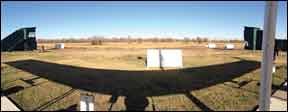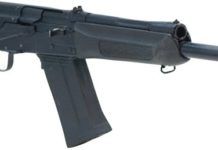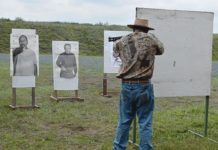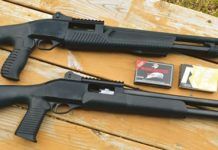Benelli’s super-lightweight shotguns, the Ultralight line, are touted as being the lightest semi-automatic shotguns in production. Because a lighter gun does not always leave a shooter happy after a long day in the field or an afternoon shooting sporting clays, there are good reasons why shooters would prefer a heavier classic model, such as a favorite of many shooters, the Remington Model 1100. The Model 1100 was first manufactured in 1963, and with more than 50 years of production under its belt, it has earned seniority over newcomers like the Ultralight. But, because age is just a number and the new challenges the old every day, our shooters wanted to see for themselves which gun they would buy. Toward that end, we got a Benelli Ultralight Model No. 10802 12 Gauge, $1649; and Remington Model 1100 Sporting No. 25315, $1211, for this showdown.

Weight
First, let’s look at some of the ways Benelli shaved pounds to make its lightweight boomstick. The Benelli weighed in at a mere 6.4 pounds on our scale, putting the Model 1100 challenger in a different weight class at 8.4 pounds — a 31% uptick. Part of the reduction came by shortening the Ultralight’s forearm, 9 inches compared to 11.5 inches on the Remington. We initially worried that the shorter forearm would be a problem for a long-armed shooter, but one of our lanky testers handled the Benelli with no problems. With the shortened forearm comes a lower-capacity magazine tube as well, 2+1 in the Ultralight and 4+1 (unplugged) in the Model 1100. For almost all competition shooters and bird hunters, the 1100’s extra capacity is no advantage. Benelli also uses a featherweight aluminum alloy to make the Ultralight’s receiver instead of the steel receiver on the Model 1100. Another weight savings comes from the use of carbon fiber on the raised target rib.

Our Team Said: For the North Dakota pheasant hunter who pushes rather than blocks, that 2-pound savings means a lot.
Fit and Finish
Fit and finish on both guns was superb. Walnut woodwork on both was attractive, although, in our opinion, the darker, better figured woodwork on the Model 1100 looked much nicer. Also, the Remington 1100’s exterior displays a high-gloss, smooth, shiny finish on the wood. The Benelli’s matte Weathercoat finish isn’t as showy, but it was still attractive. Elsewhere, both guns feature gold triggers, which offset the dark receiver colors nicely, providing great contrast in those areas of the guns. The Remington’s Light Contour barrel was made of gorgeous high-polish blued steel.
Our Team Said: Some shooters preferred the traditional look of the Remington, others the cleaner lines of the Benelli. Overall, we gave the 1100 a slight edge in cosmetics, but your mileage may vary.
Handling
We became familiar with the two shotguns by dry-shouldering and snap-capping them. One of the first things we noticed was how much lighter the Benelli actually felt, beyond what the scale said. Weighing in at just over 6 pounds and measuring 47.5 inches in length, the Ultralight was very fast to target. The length of pull measured 14.25 inches with a drop at comb of 1.5 inches, a drop at the heel of 2.25 inches, and a drop at toe of 7 inches.
Switching to and from the Model 1100 seemed outrageous. The Sporting felt like swinging around a bazooka, being a longer, heavier gun. It weighed in at 8.4 pounds and measured 49 inches in length. With a length of pull of 14 inches, a 1.5-inch drop at comb, and a drop at heel and toe of 2.25 and 6.9 inches, respectively, the Sporting’s dimensions will fit most people well, as it did our team shooters.
Our Team Said: You’ll feel the Benelli’s weight savings even on a short trek from car to the field. The Benelli’s stock shim kit allows for substantial changes in the fit, so that alone is a major advantage, assuming you know how to fit shotguns.
Choke Tubes and Patterning
The Benelli Ultralight ships with three screw-in Crio choke tubes in Improved Cylinder, Modified, and Full constrictions. The Crio choke tubes are part of Benelli’s trademarked system of freezing both the barrels and the chokes of the shotguns at -300 F. This cryogenic treatment supposedly removes stress left in the barrel after being hammer forged, and those stresses are claimed to cause the barrel to expand or contract unpredictably on firing. We’re skeptical about the value of this treatment for shotgun barrels (and rifle barrels, for that matter), but we also don’t like to run away from data.
The Sporting came with four Remington Extended Stainless tubes in SK, IC, LM, and M constrictions. Installing and removing the Rem chokes was much easier because they didn’t require a wrench like the Benelli did.
We patterned the Benelli with the IC choke installed first, and much to our surprise, the Crio marketing rang true.
At the patterning station, we used Winchester AA Target Loads (2.75 inch, 1-ounce shotcharge, No. 7 1/2 shot) to shoot HunterJohn Clay Pigeon & Sporting Clays Shotgun Pattern Targets. Rather than starting with the shotgun mounted and aiming at the bullseye, we start in the down-gun position, then mount the shotgun smoothly and on a regular pace to fire three patterning shots. This also exposes how the shotgun points.
The Ultralight put more lead on the target than the Remington and in a much tighter center grouping. The Benelli produced almost a 50/50 split both horizontally and vertically. The 1-ounce AA shotshells contain about 350 pellets, so the projected IC density should have been about 45% (158 pellets) of shot in a 30-inch circle at 40 yards. The Ultralight put 183 impacts (51%) in a very even pattern, with only four clays (according to the shadow clay-target images) not being broken over three targets.
When we patterned the Model 1100, we were expecting similar results, but the patterning on the Model 1100 was way off. While it put more lead on the target with 202 total pellets (57%, or what we would expect from a Modified constriction), the 1100’s dispersion over the 30-inch circle wasn’t what we were expecting. We found 80 of the 202 pellets were in the lower left quadrant of the target, with another 62 in the lower right quadrant. Or in other words, 71% of the shotcharge was in the lower half of the pattern, which generally would only be an advantage on falling targets. Also, we noted seven missed birds inside the patterns.
Our Team Said: The differences in pattern density can be changed by installing a different choke, so that doesn’t much bug us. But in our limited patterning tests, the Benelli distributed shot charges more evenly. Also, the Benelli is chambered for 3-inch shells, whereas the Remington accepts 2.75-inch shells.
In The Field
To prove the guns on moving targets, we headed over to American Shooting Centers in Houston to shoot Wobble Trap and 5 Stand. On moving targets, the Ultralight took some getting used to because we had a tendency to overcorrect or swing through targets too much because the gun was so light. After the first stand, things started to come together. We were able to adjust to the gun’s light weight and had no problem the rest of the day. The red-bar sight of the Benelli made it easy to put the barrel ahead of the target, and we generally didn’t notice our eyes focusing on the sight instead of the target.
The Benelli Ultralight is powered by the Inertia Driven system instead of the gas system used in the Remington Model 1100. The Inertia Driven system is a much simpler mechanism. As Benelli describes it, when the trigger is pulled, every part of the shotgun moves rearward, except the bolt body. The curved track in the bolt body, which is moving forward, presses against the locking head pin, turning the bolt tighter into the barrel extension. At the same time, the inertia spring is compressed between bolt head and body. The cartridge drop lever moves, allowing a shell to move from the magazine to the carrier. Near the end of the recoil cycle, chamber pressure drops to a safe level and the gun’s rearward motion slows. The inertia spring then thrusts the bolt assembly rearward, unlocking the bolt head, and extracting the spent shell. As the empty shell leaves the receiver, the energy of the moving bolt assembly re-cocks the hammer and compresses the recoil spring. The recoil spring thrusts the bolt assembly forward, lifting the new shell into position and chambering a fresh cartridge. All of this takes place in a fraction of a second, and the gun is ready to fire again.
Benelli claims the Inertia Driven system offers quite a few advantages over the gas system. They say their gun is more reliable because it does not require adjusting for different loads, but we didn’t have any issue changing loads with the Remington, either. Benelli says its shotguns run cleaner because the gas, smoke, and burnt powder stay in the barrel instead of being pushed back in to the gun’s body. During our shooting, we found this to be true. Cleanup of the barrel, chokes, and internal components was a snap because those parts weren’t very dirty. Benelli also claims the ID-system is more reliable because it has only three parts: the bolt body, the inertia spring, and the rotating bolt head. We didn’t experience failures with either gun, but the Benelli was obviously lighter, and the action accounts for some of the weight savings.
Our Team Said: The recoil on the Ultralight was astonishingly low for such a light gun. For most of our team, there was not a perceivable difference between the two guns, and after shooting all afternoon, no one’s shoulder was bruised or banged up. However, at the end of the day, smaller-framed testers compared the Ultralight’s recoil to being “punched in the arm by a fifth grader” all day.
Apart from the astonishing difference that 2 pounds can mean even on a trap course, the Model 1100 lived up to its name. We shot with it all day, and it was the reliable workhorse that it has become known as. We didn’t have any misfeeds or failures to eject. Some members of our team even preferred the Remington Model 1100 because of its familiarity and because the heavier gun was easier to swing through with while shooting. The Remington Model 1100 also features a Sporting Clays-style rubber buttpad, something that we would have liked to see on the Benelli.
All in, our team would buy the Benelli Ultralight ahead of the Remington 1100 Sporting for general shooting chores, including a light amount of various shotgun games. For heavy-duty target shooting only, we’d give the nod to the Sporting because that’s what it was made for.
Written and photographed by John Taylor, using evaluations from Gun Tests team testers. GT




























